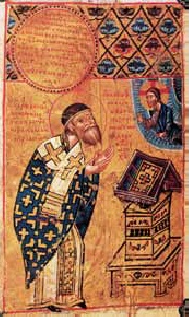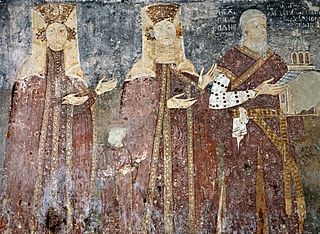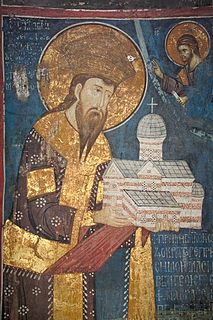 W
WGradislav Borilović was a Serbian magnate in the service of Stefan Uroš III Dečanski and Stefan Dušan, having the titles of vojvoda (general), kaznac, and tepčija. Gradislav led the Serbian army that fought the Ottoman emirate at the Battle of Demotika in October 1352. The battle was fought between the allies of the two rival Byzantine Emperors, John V Palaiologos and John VI Kantakouzenos, and it was the first major battle of the Ottomans on European soil, which ended in a Serbian defeat. Greek sources spoke of Gradislav as "truly one of the most respectable among the Serbs".
 W
WDejan Manjak was a nobleman in the service of Serbian King Stefan Dušan, only mentioned in a charter dated January 22, 1333, in which Stefan Dušan officially sold Ston and Prevlaka to the Republic of Venice. Based on the order in which the witnesses appear, vojvoda Dejan was of lower rank than stavilac Miloš.
 W
WDragoslav or Jovan Dragoslav was a Serbian nobleman with the titles of kaznac, and then veliki kaznac, serving King Stefan Milutin. The kaznac was a financial-taxation office, translated into Latin camerarius (chamberlain). In the hierarchy of the Serbian court, kaznac ranked higher than stavilac and čelnik, and lower than tepčija and vojvoda, the supreme title. He was part of the generation of Serbian nobility that were empowered in the early 14th century.
 W
WĐuraš Ilijić was a nobleman who served the Serbian monarchs Stefan Dečanski, Stefan Dušan and Uroš V, from 1326 until his death in 1362. He had the title of čelnik ("head"), and governed Upper Zeta. He is an ancestor of the Crnojević noble family.
 W
WJakov of Serres was a medieval Serbian writer, scholar, translator, and hierarch of the Serbian Orthodox Church, one of the most important men of letters working in the 14th century.
 W
WMrnjava was a Serbian provincial nobleman, born in Zahumlje, a frontier province in the western Serbian Kingdom. Mrnjava is the eponymous founder of the notable Mrnjavčević family; his son Vukašin Mrnjavčević became the co-ruler of the Serbian Empire (1365–1371) as king during the fall of the Serbian Empire.
 W
WMrnjava was a Serbian provincial nobleman, born in Zahumlje, a frontier province in the western Serbian Kingdom. Mrnjava is the eponymous founder of the notable Mrnjavčević family; his son Vukašin Mrnjavčević became the co-ruler of the Serbian Empire (1365–1371) as king during the fall of the Serbian Empire.
 W
WPetar Brajan was a Serbian župan (count) that built the White Church in Karan, Užice, as a family funeral church. The church was erected on site of an older temple from the 10th century, mentioned in a charter edited by Byzantine Emperor Basil II in 1020. There are fresco portraits of Brajan and his family and of the Serbian Emperor Stefan Dušan, and his son Uroš V.
 W
WPribil was a Serbian župan (count) who built the Dobrun Monastery in Dobrun, Višegrad, as a family funeral church. He founded the church together with his sons, župan Petar and župan Stefan. There are frescoes of the family, and of a higher-ranked nobleman, protovestijar Stan, who was Pribil's father-in-law.
 W
WAndrija was the Prince of Hum (Zahumlje) in 1216–1218 and c. 1250.
 W
WSaint Sava II was the third Archbishop of the Serbian Orthodox Church, serving from 1263 until his death in 1271. He was the middle son of King Stefan the First-Crowned of the Nemanjić dynasty and his Byzantine wife Eudokia Angelina. He had two brothers, Stefan Radoslav and Stefan Vladislav, and a sister, Komnena. Predislav took the monastic name of Sava, after his uncle, Saint Sava, the first Serbian Archbishop. The Serbian Orthodox Church celebrates him as a saint and his feast-day is 21 February.
 W
WShishman was a Bulgarian nobleman (boyar) who ruled a semi-independent realm based out of the Danubian fortress of Vidin in the late 13th and early 14th century. Shishman, who was bestowed the title of "despot" by Bulgarian emperor George Terter I, was a Cuman, and may have been established as lord of Vidin as early as the 1270s.
 W
WStanislav of Lesnovo or Stanislav Gramatik, was a Serbian writer, a scribe in the monastery of Lesnovo.
 W
WStefan Uroš III Nemanjić, known as Stefan Dečanski, was the King of Serbia from 6 January 1322 to 8 September 1331. Dečanski was the son of King Stefan Milutin, and he defeated several of his family members vying for the throne. He took his epithet Dečanski from the great monastery he built at Dečani.
 W
WStefan Uroš I, known as Uroš the Great was the King of Serbia from 1243 to 1276, succeeding his brother Stefan Vladislav. He was one of the most important rulers in Serbian history.
 W
WTheodora of Bulgaria was a Bulgarian princess and Queen consort of Serbia, the first wife of Stefan Uroš III Dečanski. She was the second daughter of Tsar Smilets of Bulgaria and Smiltsena Palaiologina. She is best remembered as a patron of the Arts, Music and Literature. Among her heirloom, one of the most famous rings from the fourtheenth century was found, now on display in the National Museum in Belgrade. That golden ring has the carved inscription: "May the Lord help the one who wears it."
 W
WVukdrag was a Serbian nobleman who served King Stefan Dečanski as čelnik. He was a magnate in the Rudnik mountain area, who founded the Raška style church in Dići, below the Rudnik, before 1327, most likely as a family temple. He must have had one of the important gubernatorial functions in the Rudnik oblast (province) during the reigns of kings Stefan Milutin and Stefan Dečanski. Unknown in historical sources, he was buried in his church, where his gravestone inscription tells that he died on 8 May 1327, on the Feast of the Ascension (Spasovdan), and that he had taken monastic vows as Nikola (Никола) and [once] held the title of čelnik. It is unclear if there was one or several individuals with that title at the court at that time; Đuraš Ilijić was mentioned with the title in 1326, and Gradislav Vojšić, for the second time, in 1327. He was buried in a special tomb inside the church, and his gravestone was set by his wife Vladislava. The unearthing of the gravestone gave new facts in the understanding of the territorial contours of the Serbian state north of Rudnik at the end of the 13th- and beginning of 14th century. The largest medieval necropolis in Serbia was unearthed around the church, with flat gravestones belonging to the oldest phase of the Stećak culture.